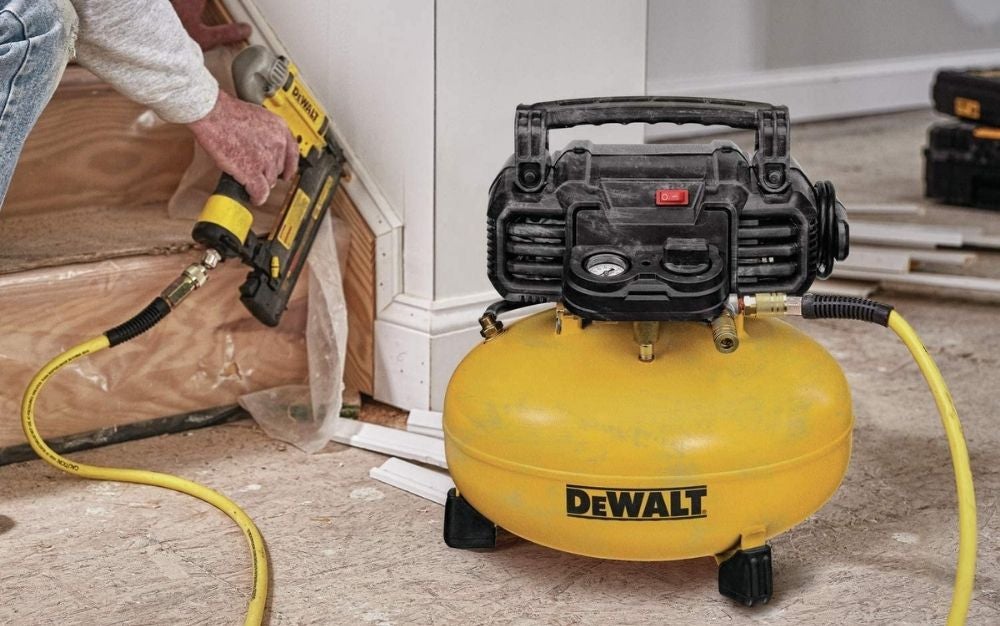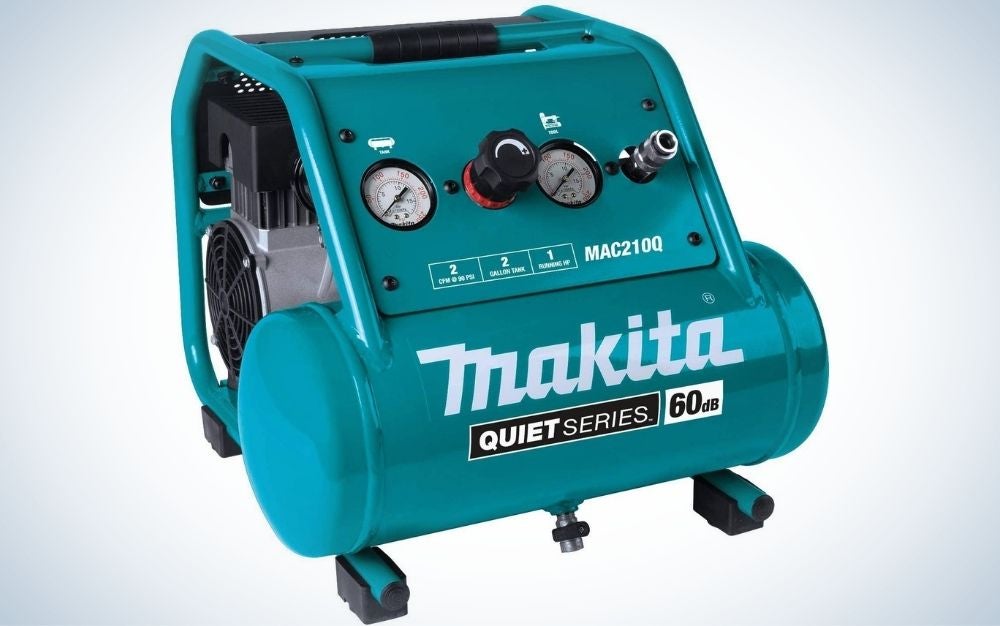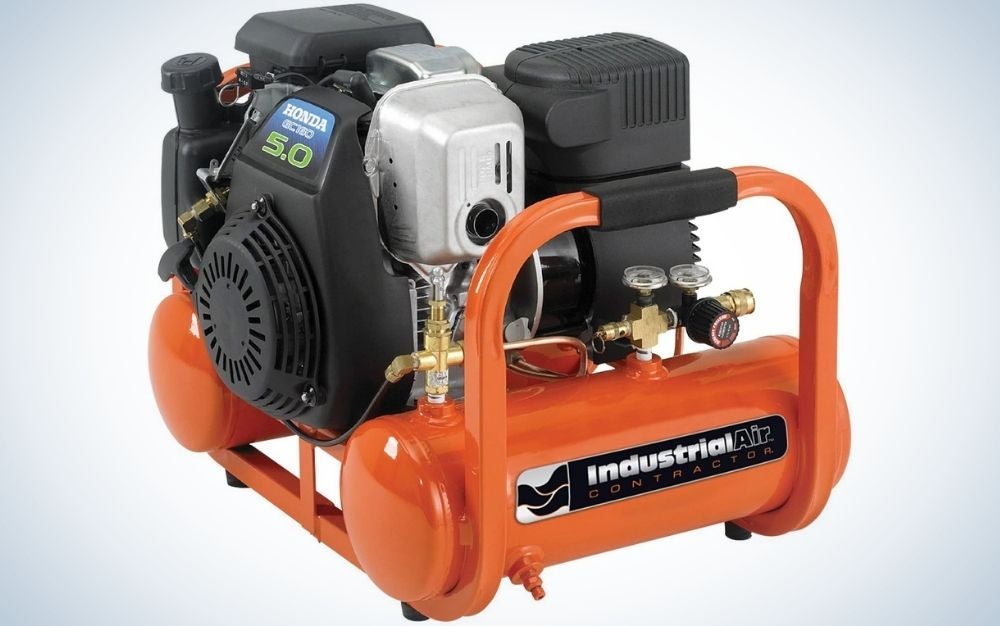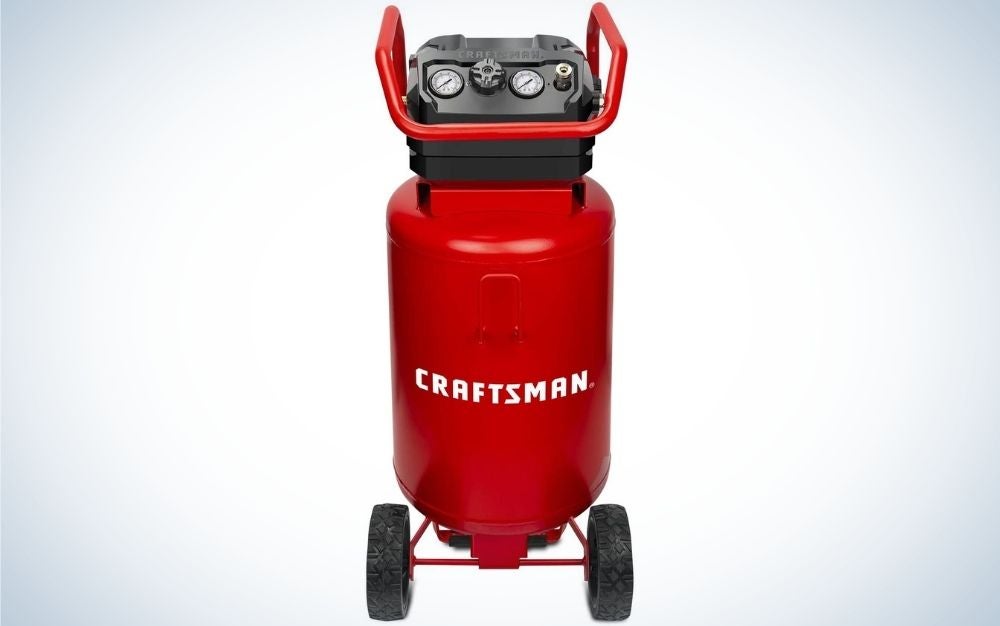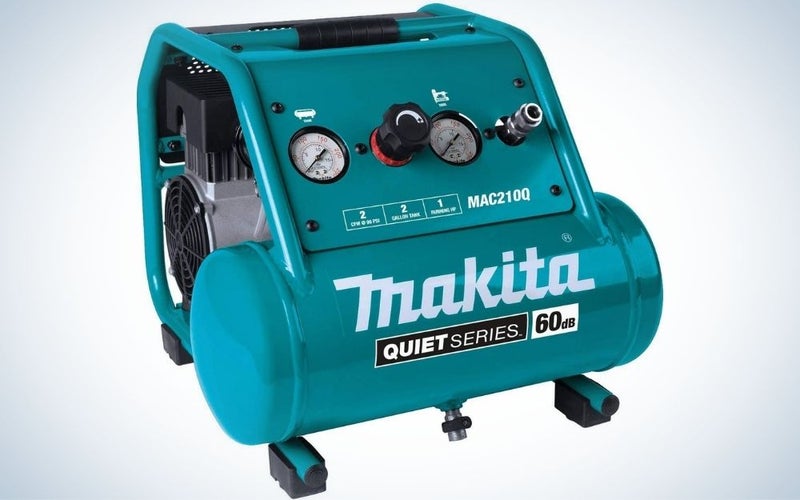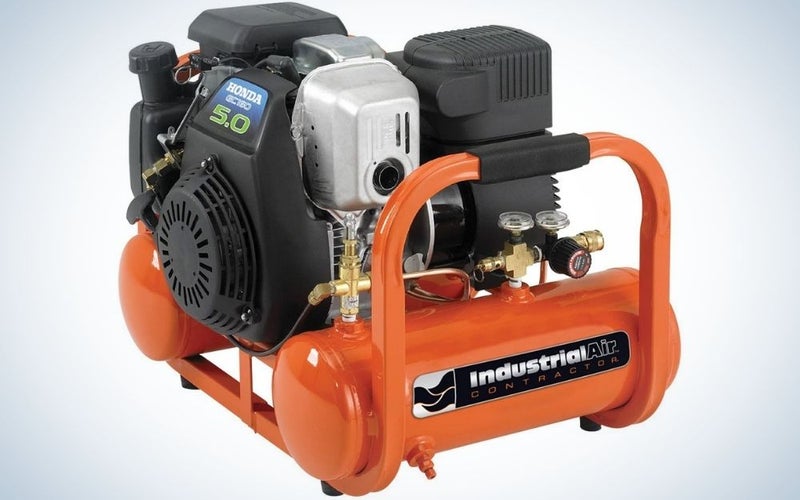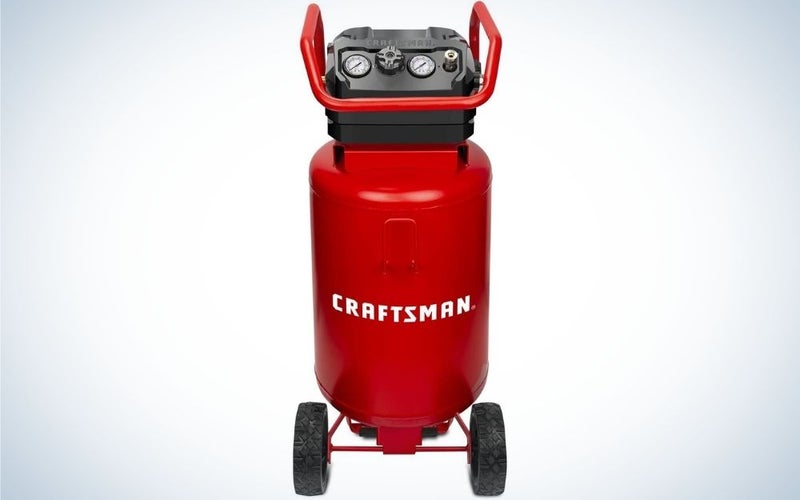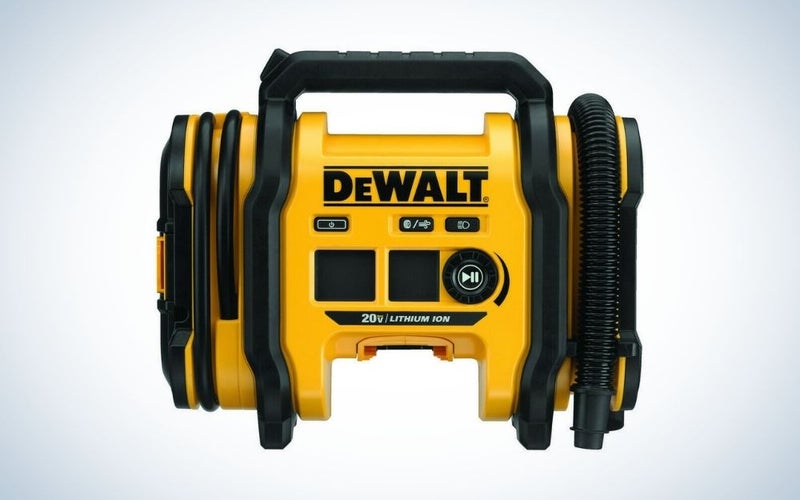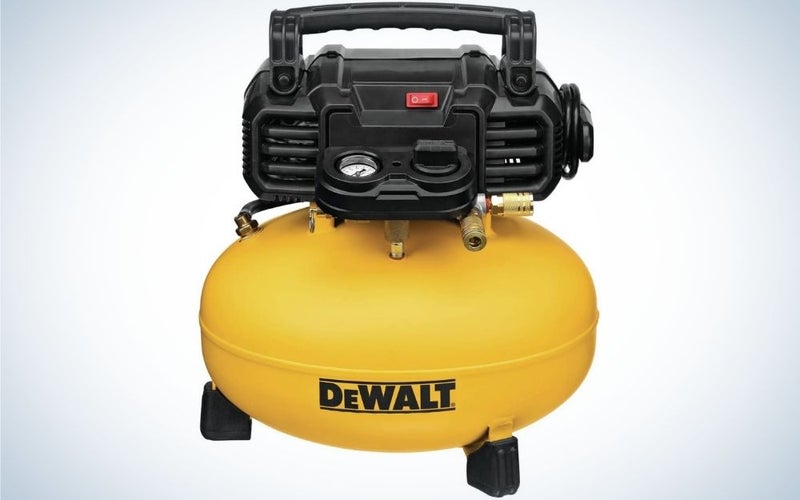We may earn revenue from the products available on this page and participate in affiliate programs. Learn more ›
An air compressor is the most versatile tool that home shops and garages often do not have. Why compressed air? In addition to the ability to inflate tires and balls, it is useful for blowing out dusty corners and other cleanup projects. But the best air compressors and pneumatic (air-powered) tools offer way more functionality than just blowing air. Virtually all handheld electric and cordless power tools can be replaced with smaller, more powerful, lightweight pneumatic versions.
Sure, you’ll use your air compressor to inflate tires, but the best reason to buy an air compressor is to power a variety of air tools. The greatest benefit of air tools is that they are very powerful and don’t require their own motors. There are no batteries to replace, and the only maintenance is occasional oiling. This brings the cost per tool way down relative to either corded or cordless electric power tools, so the cost savings on the tools helps offset the price of the compressor. A bonus benefit is that air tools are more compact than their electric or cordless counterparts, so they store better in a limited space.
- Best overall: Makita MAC210Q Quiet Series
- Best gas-powered: Industrial Air Contractor Portable Air Compressor
- Best for home shops: CRAFTSMAN Air Compressor
- Best for the car: DEWALT 20V MAX Cordless Tire Inflator
- Best budget: DEWALT Pancake Air Compressor
The best air compressors: Reviews & Recommendations
Best overall: Makita MAC210Q Quiet Series
Makita
Its compact footprint means this Makita easily tucks away when not in use. And when it is out the feature that immediately stands out is a complete roll cage design that fully protects the motor and components from collision damage. At only 44 pounds, it is lightweight and easy to carry with a padded handle. Provides 2 CFM at 90 PSI.
Best gas-powered: Industrial Air Contractor Portable Air Compressor
Industrial Air Contractor
Driven by a 5-horsepower Honda engine, this gas-powered air compressor is capable of energizing a variety of high-volume air tools. The twin pontoon-style tanks hold 2 gallons each for a good balance of air volume and portability. Delivers an impressive 5 CFM at 90 PSI.
Best for home shops: CRAFTSMAN Air Compressor
Craftsman
With a space-saving upright configuration, this 20-gallon air compressor will run a shop full of pneumatic Craftsman power tools, including many of the higher-volume types. Convenience features include dual quick connectors, large pressure gauges, easy turn pressure adjustment knob, and durable rubber wheels. Delivers 4 SCFM at 90 PSI.
Best for the car: DEWALT 20V MAX Cordless Tire Inflator
Walmart
Offering either high-pressure or high-volume inflation of car, truck, and SUV tires, sports balls, and air mattresses, this compressor has a convenient three-way power supply that lets you choose from 110V AC, 12V DC, or 20V MAX battery power. Special features include a digital high-pressure inflation mode with auto shutoff, onboard LED flashlight, internal accessory storage, heavy-duty rubber feet for stability, and a threaded chuck to connect securely. Maximum output is 160 PSI.
Best budget: DEWALT Pancake Air Compressor
Dewalt
This pancake air compressor offers ample volume, holding 6 gallons of air at a maximum 165 PSI for efficient tool operation without overworking the motor. It achieves higher CFM than the competition, thanks to a high flow air regulator and couplers, providing excellent tool performance. Delivers 2.6 SCFM at 90 PSI.
What to look for when shopping for the best air compressors
Some air tools, like nailers and staplers, operate with a burst of pressurized air. Others, like blowguns, air sanders, and impact wrenches, require a steady flow of high-pressure air. The air volume and pressure needed to run different kinds of tools varies, so the kinds of power tools you wish to use will help to determine the best air compressor to buy.
Compressor power is rated in pounds per square inch (PSI) and cubic feet per minute (CFM). PSI is the measurement of air pressure, while CFM tells the volume of airflow over time. Air tools list similar ratings according to what it takes for them to operate correctly. To ensure that your tools will work with the compressor you choose, refer to the tools with the highest PSI and CFM requirements. If you plan to use multiple tools at once, combine the CFM of all tools that would be used simultaneously. The best air compressor will exceed the airflow requirements of your tools by at least 25 percent. Tank size matters, too. The volume of air in the tank affects how well certain tools work. Power tools that require constant airflow perform best when the compressor has a larger air tank.
Related: Got a big cleanup job at home? These are the best vacuums for hardwood floors.
How and where you use your air compressor should inform your choice
Air compressors are powered either by electricity or gasoline. Electric air compressors are much more common in homes and small businesses because they can be used in a variety of settings, indoors or out. Those powered by gasoline are limited to outdoor use and require more ongoing maintenance, but they also offer more powerful performance.
For remote or off-grid work, a gas air compressor may be the best pick
A gas-powered air compressor is a good choice for remote projects away from electric service. It can be an invaluable apparatus not only for powering tools, but also for inflating tires and even pressure washing. Some customers choose combination machines that incorporate an air compressor with a generator or welder.
An air compressor for the shop needs more air-handling ability and tank capacity for heavy-duty tools
This tool could be a game-changer, but buying a small air compressor that is too weak to power your angle grinder or paint sprayer will cause more irritation than elation. Consider the full range of tool possibilities before settling on a particular model. You may only have a finish nailer today, but if you’re planning to buy an impact wrench in the future, go for the bigger compressor to be prepared with enough power.
Reasons why a portable air compressor may be the right choice
Another important consideration is portability. You may do most of your projects in the garage at this point, but if you decide to go all-in with air tools, ease of transporting the unit becomes an important feature. Consider all of the places you’ll use the compressor and how easily the unit could be moved there. A tire inflator is an inexpensive, tankless air compressor that conveniently stores in the trunk of a car or behind the seat of a pickup truck. The better models produce ample air pressure to maintain automobile and bike tires and to inflate balls or air mattresses.
What is the best air compressor to keep on hand, just in case?
If you’re looking for a versatile air compressor for occasional use, a quality, low-cost pick will be right up your alley. A compact pancake air compressor could be the best choice for storage, or a wheeled hotdog-style compressor might be easier to move around. Both styles come in at lower price points, but offer plenty of functionality for weekend use. Note: Although some ready-to-go kits are available, most air compressors are sold with no tools or attachments included, meaning you’ll need to purchase the air hose separately along with any tools you may need.
FAQs
Q: What size air compressor do I need to run air tools?
A compressor with a rating of 40 to 140 cubic feet per minute (CFM) is sufficient to operate many different air tools. Those at the lower end of this spectrum are best suited for single tool use, while those at the higher end may accommodate a partner working simultaneously on a second line. Air tank volume determines how often the motor runs to maintain working pressure. For home use, tank sizes in the 6- to 20-gallon range are generally sufficient.
Q: Which is better: oil or oilless air compressor?
The rod and piston in an air compressor need lubrication to keep from overheating. Some compressors use oil that must be properly maintained, while oilless compressors use a slick material coating to provide permanent lubrication. For most private users and indoor use, oilless is a better option due to cleaner, quieter operation, plus minimal maintenance requirements. Oil air compressors may be a better choice where higher RPMs/PSI are required, or for hot, humid working conditions where rust or corrosion could become problematic.
Q: Can you leave air in your compressor?
Always drain the air from the compressor when it is not in use. Compressed air produces condensation inside the tank. If not drained, it can cause the tank to rust from the inside out. If the compressor is used daily, it should be drained at least once every two or three days.
The final word on purchasing the best air compressors
- Best overall: Makita MAC210Q Quiet Series
- Best gas-powered: Industrial Air Contractor Portable Air Compressor
- Best for home shops: CRAFTSMAN Air Compressor
- Best for the car: DEWALT 20V MAX Cordless Tire Inflator
- Best budget: DEWALT Pancake Air Compressor
No one wants to spend a pile of cash on equipment that clutters up the garage. Air compressors offer loads of utility, but each style excels in different applications. A great tool in your neighbor’s woodshop may be a dud in your home shop. The best air compressor for you may be completely off the neighbor’s radar. Now you have some knowledge about how these machines work and what they can do. If you are not sure the time is right to buy, a good next step would be to research a variety of pneumatic tools that may be useful and find out about their capabilities and airflow requirements. One of the above compressors could be a good match for your needs.
Why trust us
Popular Science started writing about technology more than 150 years ago. There was no such thing as “gadget writing” when we published our first issue in 1872, but if there was, our mission to demystify the world of innovation for everyday readers means we would have been all over it. Here in the present, PopSci is fully committed to helping readers navigate the increasingly intimidating array of devices on the market right now.
Our writers and editors have combined decades of experience covering and reviewing consumer electronics. We each have our own obsessive specialties—from high-end audio to video games to cameras and beyond—but when we’re reviewing devices outside of our immediate wheelhouses, we do our best to seek out trustworthy voices and opinions to help guide people to the very best recommendations. We know we don’t know everything, but we’re excited to live through the analysis paralysis that internet shopping can spur so readers don’t have to.
